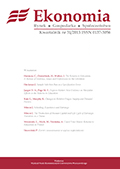Polityka pieniężna państw nadbałtyckich - nowych członków Unii Europejskiej
Monetary Policy of the Baltic States - new EU Members
Author(s): Wiesława Przybylska-KapuścińskaSubject(s): Economy
Published by: Uniwersytet Warszawski - Wydział Nauk Ekonomicznych
Summary/Abstract: On 1 May 2004, new East and Central European states that had made a major breakthrough in their social and economic system found themselves within the European Union area. A fundamental decision of capital importance for their future had been the transformation of centrally planned economies into market economies. This required an extreme determination, consistence and sacrifices, and entailed different social and economic costs. The economies in transformation carried out many indispensable reforms and among them changes in the functioning of the banking sector, development of an independent central bank and choice of a defined monetary policy strategy. The fundamental problem in the monetary policy of the East and Central European countries was the necessity to get under control the high inflation and build up the credibility of their national currencies in the face of both the changing external conditions and the differentiation of the political, economic and social situation in the group of the countries in question. Stabilization of prices on a low level became the main criterion in the adaptation processes of those countries on their road to integration with the European Community structures. This criterion also became the most important determinant of the monetary policy and its strategies adopted by the individual countries running for the EU membership. The paper focused on presentation of the methods adopted by the group of East European Baltic countries in the conduct of their economic policy. Thus, the monetary policy of Lithuania, Latvia and Estonia was presented. These three countries distinguish themselves among the new EU members by their geopolitical situation because all of them have emerged from the disintegration of the Soviet Union and constitute a relatively homogeneous group of economies in transformation. Certain elements of homogeneity can also be observed in the monetary policy adopted by them. In the first part of the paper, the essence of the exchangerate strategy applied in practice by the new Baltic EU member countries was characterized. Then, in consideration of the fact that the most important conditions substantial from the point of view of the monetary policy, and related to the accession of the countries in question to the Eurosystem, were the independence of the central bank and the definition of the main goal of their monetary policy so as to make it compatible with the goal of the European Central Bank, the process of shaping the monetary policy in the individual countries was presented in more detail, in concentrating on the problem of institutional independence of the central bank and on the main goals and instruments of the monetary policy. Also, the course of the inflationary processes over the period of 1997–2005 was monitored.
Journal: Ekonomia. Rynek, Gospodarka, Społeczeństwo
- Issue Year: 2007
- Issue No: 19
- Page Range: 31-51
- Page Count: 21
- Language: Polish

